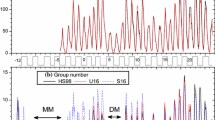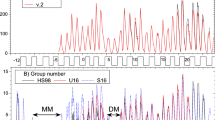Abstract
Continuous direct records of solar variability are limited to the telescopic era covering approximately the past four centuries. For longer records one has to rely on indirect indices such as cosmogenic radionuclides. Their production rate is modulated by magnetic properties of the solar wind. Using a parameterisation of the solar activity and a Monte Carlo simulation model describing the interaction of the cosmic rays with the atmosphere, the production rate for each cosmogenic nuclide of interest can be calculated as a function of solar activity. Analysis of appropriate well-dated natural archives such as ice cores or tree rings offers the possibility to reconstruct the solar activity over many millennia. However, the interpretation of the cosmogenic nuclide records from these archives is difficult. The measured concentrations contain not only information on solar activity but also on changes in the geomagnetic field intensity and the transport from the atmosphere into the archive where, under ideal conditions, no further processes take place. Comparison of different nuclides (e.g. 10Be and 14C) that are produced in a very similar way but exhibit a completely different geochemical behaviour, allows us to separate production effects from system effects.
The presently available data show cyclic variability ranging from 11-year to millennial time scale periodicities with changing amplitudes, as well as irregularly distributed intervals of very low solar activity (so called minima, e.g. Maunder minimum) lasting typically 100 years.
Similar content being viewed by others
References
Bard, E., Hamelin, B., Fairbanks, R. G., and Zindler, A.: 1990, ‘Calibration of the 14C time scale over the past 30,000 years using mass spectrometric U-Th ages from Barbados corals’, Nature 345, 405–410.
Bard, E., Raisbeck, G. M., Yiou, F., and Jouzel, J.: 1997, ‘Solar modulation of cosmogenic nuclide production over the last millenium: comparison between 14C and 10Be records’, Earth. Planet. Sci. Let. 150, 453–462.
Baumgartner, S., Beer, J., Masarik, J., Wagner, G., Meynadier, L., and Synal, H.-A.: 1998, ‘Geomagnetic modulation of the 36Cl flux in the GRIP ice core, Greenland’, Science 279, 1330–1332.
Baumgartner, S., Beer, J., Wagner, G., Kubik, P. W., Suter, M., Raisbeck, G. M., and Yiou, F.: 1997, ‘10Be and dust’, Nucl. Instr. Meth. B123, 296–301.
Beer, J., AndrÈe, M., Oeschger, H., Siegenthaler, U., Bonani, G., Hofmann, H., Morenzoni, E., Nessi, M., Suter, M., Wölfli, W., Finkel, R., and Langway Jr., C.: 1984, ‘The Camp Century 10Be Record: Implications for Long-Term Variations of the Geomagnetic DipoleMoment’, Nucl. Instrum. Meth. B5, 380–384.
Beer, J., Baumgartner, S., Hannen-Dittrich, B., Hauenstein, J., Kubik, P., Lukasczyk, C., Mende, W., Stellmacher, R., and Suter, M.: 1994, ‘Solar Variability Traced by Cosmogenic Isotopes’, in The Sun as a Variable Star: Solar and Stellar Irradiance Variations, J. M. Pap, C. Fröhlich, H. S. Hudson and S. K. Solanki (eds.), pp. 291-300, Cambridge University Press.
Beer, J., Blinov, A., Bonani, G., Finkel, R. C., Hofmann, H. J., Lehmann, B., Oeschger, H., Sigg, A., Schwander, J., Staffelbach, T., Stauffer, B., Suter, M., and Wölfli, W.: 1990, ‘Use of 10Be in polar ice to trace the 11-year cycle of solar activity’, Nature 347, 164–166.
Beer, J., Mende, W., R., S., and White, O. R.: 1996, ‘Intercomparisons of proxies for past solar variability’, in Climate variations and forcing mechanisms of the last 2000 years, P. D. Jones, R. S. Bradley and J. Jouzel (eds.), Vol. I41, Springer-Verlag, Heidelberg.
Beer, J., Mende, W., and Stellmacher, R.: 2000, ‘The role of Sun in climate forcing’, Quat. Sci. Rev. 19, 403–415.
Beer, J., Raisbeck, G. M., and Yiou, F.: 1991, ‘Time Variations of 10Be and Solar Activity’, in The Sun in Time, C. P. Sonett, M. S. Giampapa and M. S. Matthews (eds.), pp. 343-359. Univ. of Arizona press, Tucson.
Beer, J., and Sturm, M.: 1995, ‘Dating of lake and loess sediments’, ‘Radiocarbon 37, 81–86.
Beer, J., Tobias, S. M., and Weiss, N. O.: 1998, ‘An active Sun throughout the Maunder minimum’, Solar Physics 181, 237–249.
Broecker, W. S., Sutherland, S., and Peng, T.-H.: 1999, ‘A possible 20th-century slowdown of southern ocean deep water formation’, Science 286, 1132–1135.
Brost, R. A., Feichter, J., and Heimann, M.: 1991, ‘Three-dimensional simulation of 7Be in a global climate model’, J. Geophys. Res. 96, 22,423–22,445.
Damon, P. E., and Jirikowic, J. L.: 1992, ‘The Sun as a low-frequency harmonic oscillator’, Radiocarbon 34, 199–205.
Finkel, R. C. and Nishiizumi, K.: 1997, ‘Beryllium-10 concentrations in the Greenland ice sheet project 2 ice core from 3–40 ka’, J. Geophys. Res. 102, 26,699–26,706.
Fröhlich, C., and Lean, J.: 1997, ‘Total Solar Irradiance Variations’, in IAU Symposium 185, F. L. Deubner (ed.), Kluwer Academic Publ., Dordrecht.
Fröhlich, C.: 2000, Space Sci. Rev., this volume.
Gilliland, R. L.: 1981, ‘Solar radius variations over the past 265 years’, Astrophys. J. 248, 1144–1155.
Gleissberg, W.: 1965, ‘The eighty-year solar cycle in auroral frequency numbers’, J. Br. Astron. Assoc. 75, 227.
Hajdas, I.: 1993, ‘Extension of the Radiocarbon Calibration Curve by AMS Dating of Laminated Sediments of Lake Soppensee and Lake Holzmaar’, PhD Thesis, ETH Zürich.
Hughen, K., Overpeck, J. T., Lehmann, S., Kashgarian, M., Southon, J., Peterson, L. C., Alley, R., and Sigman, D. M.: 1998, ‘Deglacial changes in ocean circulation from an extended radiocarbon calibration’, Nature 391, 65–68.
Kitagawa, H., and Van der Plicht, J.: 1998, ‘A 40,000-year varve chronology from lake Suigetsu, Japan: Extension of the 14C calibration curve’, Radiocarbon 40, 505–515.
Lean, J.: 1997, ‘The Sun's variable radiation and its relevance for Earth’, Ann. Rev. Astron. Astrophys. 35, 33–67.
Masarik, J., and Beer, J.: 1999, ‘Simulation of particle fluxes and cosmogenic nuclide production in the Earth's atmosphere’, J. Geophys. Res. 104, 12,099–13,012.
McCormac, F. G., Hogg, A. G., Higham, T. F. G., Lynch-Stieglitz, J., Broecker, W. S., Baillie, M. L. L., Xiong, L., Pilcher, J. R., Brown, D., and Hoper, S. T.: 1998, ‘Temporal variation in the interhemispheric 14C offset’, Geophys. Res. Lett. 25, 1321–1324.
Mende, W. and Stellmacher, R.: 2000, Space Sci. Rev., this volume.
Pap, J. M., and Fröhlich, C: 1997, ‘Total irradiance variations’, J. Atmos. Solar-Terr. Phys., 1–13.
Scheffel, C., Blinov, A., Massonet, S., Sachsenhauser, H., Stan-Sion, C., Beer, J., Synal, H. A.,Kubik, P. W., Kaba, M., and Nolte, E.: 1999, ‘36Cl in modern atmospheric precipitation’, J. Geophys. Res. 26, 1401–1404.
Siegenthaler, U., Heimann, M., and Oeschger, H.: 1980, ‘14C Variations Caused by Changes in the Global Carbon Cycle’, Radiocarbon 22, 177–191.
Stuiver, M., and Braziunas, T. F.: 1993, ‘Sun, Ocean, Climate and Atmospheric 14CO2, an evaluation of causal and spectral relationships’, The Holocene 3, 289–305.
Stuiver, M., Reimer, P. J., Bard, E., Beck, J. W., Burr, G. S., Hughen, K. A., Kromer, B., McCormac, G., Van der Plicht, J., and Spurk, M.: 1998, ‘INTCAL98 Radiocarbon age calibration, 24,000-0 cal BP’, Radiocarbon 40, 1041–1083.
Wagner, G., Masarik, J., Beer, J., Baumgartner, S., Imboden, D., Kubik, P. W., Synal, H.-A. and Suter, M.: 2000a, Nucl. Instr. Meth., in press.
Wagner, G., Beer, J., Masarik, J., Muscheler, R., Kubik, P.W., Laj, C., Mende, W., Raisbeck, G. M., and Yiou, F: 2000b, ‘Presence of the solar de Vries cycle ( 205 years) during the last ice age’, Geophys. Res. Lett., submitted.
Wagnon, P., Delmas, R. J. and Legrand, M.: 1999, ‘Loss of volatile acid species from upper firn layers at Vostok, Antarctica’, J. Geophys. Res. 104, 3423–3432.
Willson, R. C.: 1997, ‘Total solar irradiance trend during solar cycles 21 and 22’, Science 277, 1963–1965.
Author information
Authors and Affiliations
Rights and permissions
About this article
Cite this article
Beer, J. Long-term indirect indices of solar variability. Space Science Reviews 94, 53–66 (2000). https://doi.org/10.1023/A:1026778013901
Issue Date:
DOI: https://doi.org/10.1023/A:1026778013901




